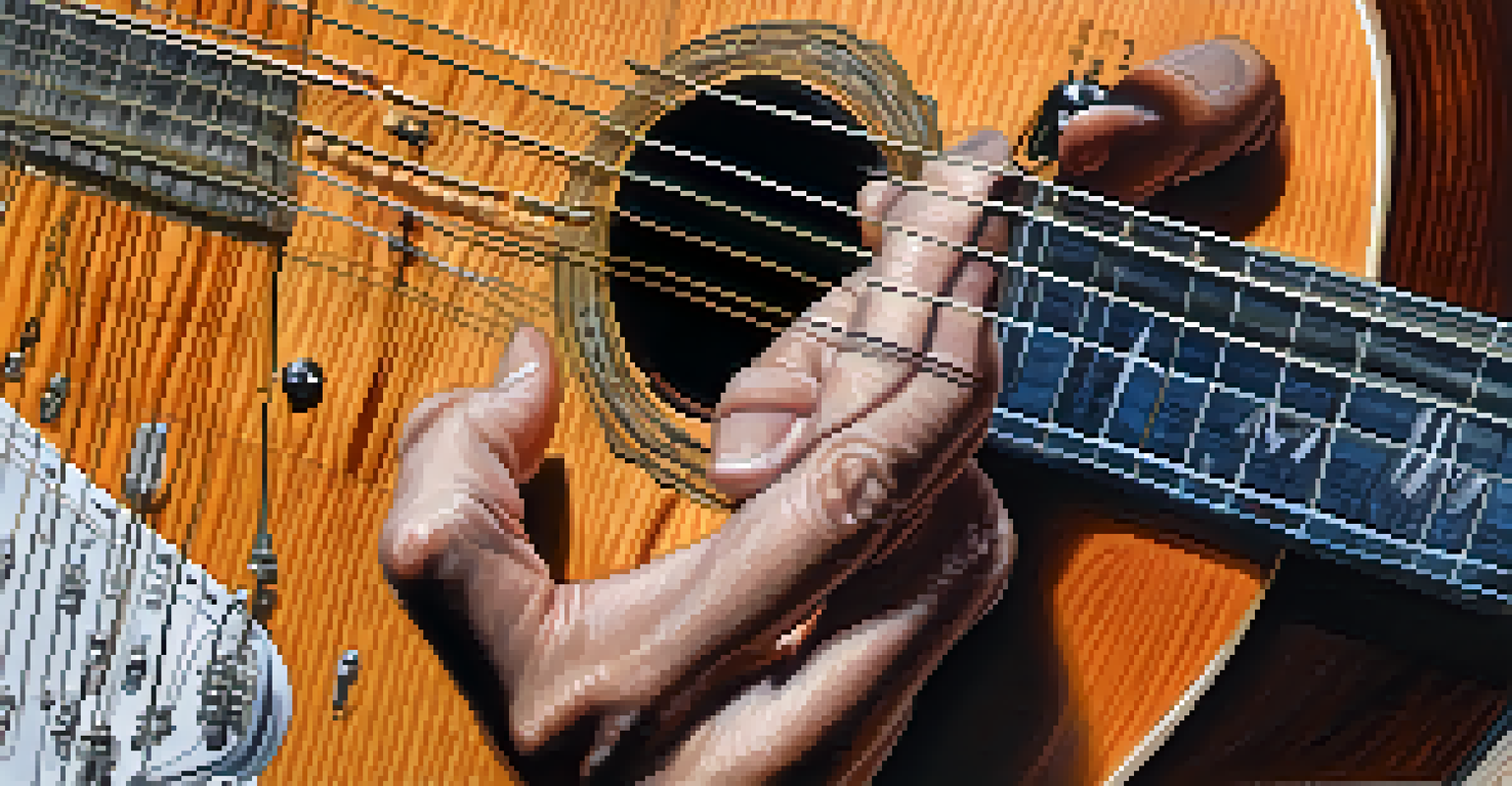Heavy Metal Guitar Techniques: Styles for Intense Play

Understanding Heavy Metal Guitar: A Foundation
Heavy metal guitar is more than just a genre; it's a powerful expression of emotion and technique. Rooted in rock, it incorporates various styles that create its intense sound. Understanding its foundational elements helps you navigate the complex world of heavy metal guitar.
Guitar playing is not just about technique; it's about expressing your emotions and connecting with your audience.
At its core, heavy metal relies on distorted tones and aggressive playing styles. Genres like thrash, doom, and black metal offer unique characteristics, but they all share a commitment to technical prowess. Familiarizing yourself with these styles is essential for mastering heavy metal.
Whether you’re drawn to the fast-paced riffs of thrash or the melodic solos of power metal, recognizing these nuances can ignite your passion. This foundation will serve as your launchpad as you delve deeper into specific techniques and styles.
Palm Muting: The Heartbeat of Heavy Metal
Palm muting is a technique that adds depth and punch to your riffs. By resting the edge of your picking hand on the strings near the bridge, you can create a muted, percussive sound that is essential in heavy metal music. This technique is particularly effective for creating rhythmic patterns.

Imagine playing a heavy riff without palm muting; it would lose that intense edge that drives the genre. When executed properly, palm muting can transform a simple riff into a powerful, driving force. It's like adding a secret ingredient to your favorite recipe—suddenly, everything tastes better!
Master Essential Techniques
Techniques like palm muting, alternate picking, and tapping are foundational for creating the intense sound of heavy metal guitar.
To practice, start with simple power chords and gradually incorporate palm muting into your playing. As you gain confidence, experiment with different rhythms and patterns. This will not only enhance your technique but also allow you to express yourself more freely.
Alternate Picking: Speed and Precision Combined
Alternate picking is a fundamental technique that every heavy metal guitarist should master. It involves alternating between downstrokes and upstrokes while picking, allowing for faster and more precise playing. This technique is crucial for executing rapid-fire riffs and solos that define heavy metal.
Music is the shorthand of emotion.
Think of alternate picking as a dance between your pick and strings, where timing and coordination are key. Like a drummer keeping a steady beat, your picking hand needs to maintain a consistent rhythm. As you practice, focus on developing a fluid motion that feels natural and effortless.
To improve your alternate picking, start slow and gradually increase your speed. Use a metronome to ensure you're maintaining a steady tempo. Over time, this technique will become second nature, and you'll notice a significant improvement in your overall playing ability.
Tapping: Adding Complexity to Your Solos
Tapping is a flashy technique that can elevate your solos to new heights. By using your fingers to 'tap' notes on the fretboard, you can create rapid and intricate patterns that sound impressive. This technique is commonly used in heavy metal solos to add a layer of complexity and flair.
Imagine a piano player dancing across the keys; that’s the kind of fluidity tapping can bring to your guitar playing. The ability to combine tapping with legato or alternate picking opens up a world of creative possibilities. It's a fantastic way to showcase your technical skills while keeping listeners engaged.
Explore Musical Modes
Understanding modes allows guitarists to add emotional depth and variety to their playing, enriching solos and compositions.
To get started with tapping, practice simple two-note patterns before moving on to more complex sequences. As you become comfortable, incorporate tapping into your solos to create unique musical phrases. With time and practice, you'll find your tapping technique becoming a signature part of your playing style.
Legato Playing: Smooth and Fluid Melodies
Legato playing is all about creating smooth transitions between notes, allowing melodies to flow seamlessly. This technique employs hammer-ons and pull-offs to achieve a fluid sound, making it perfect for crafting expressive solos. In heavy metal, legato adds a melodic touch amidst the intensity.
Think of legato as gliding over the fretboard, where each note feels connected to the next. This creates an almost vocal quality in your playing, allowing you to convey emotion and depth. It’s like painting a vivid picture with music, where each stroke contributes to the overall masterpiece.
To practice legato, focus on playing scales using hammer-ons and pull-offs. Start slowly, ensuring each note rings out clearly before increasing your speed. With dedication, legato will become an integral part of your heavy metal arsenal, enhancing your solos and riffs.
Whammy Bar Techniques: Adding Expressive Flair
The whammy bar, or tremolo arm, is a tool that can add dramatic effects to your playing. By manipulating the whammy bar while playing, you can create pitch bends, dive bombs, and other expressive techniques that enhance your sound. This adds a layer of excitement and unpredictability to your music.
Imagine the thrill of a rollercoaster as you dive and soar; that’s the kind of excitement a well-timed whammy bar effect can bring. It allows you to express emotions in ways that standard playing simply can’t achieve. Incorporating it into your solos can turn a good performance into a memorable one.
Create Your Unique Style
Combining different techniques and experimenting with your sound fosters creativity and helps develop a signature style in heavy metal guitar.
To master whammy bar techniques, start with simple pitch bends and gradually work on more complex effects. Experiment with different placements in your solos to see how it influences the overall feel. With practice, you'll find that the whammy bar becomes an extension of your musical expression.
Understanding Modes: Expanding Your Musical Palette
Modes are a powerful tool for heavy metal guitarists, providing a way to explore different musical flavors. Each mode has its own unique character, allowing you to create varied emotional landscapes in your playing. Understanding modes can significantly expand your songwriting and improvisation skills.
Think of modes as different colors on an artist's palette, each bringing its own vibe to the canvas. For instance, the Dorian mode has a jazzy feel, while the Phrygian mode adds a darker tone. By experimenting with modes, you can craft solos that resonate with a wide range of emotions.

To get started, familiarize yourself with the seven modes of the major scale. Practice playing them over different backing tracks to hear how they change the mood of your playing. As you grow more comfortable, you'll discover new sonic territories that will enhance your heavy metal compositions.
Combining Techniques: Creating Your Unique Style
The beauty of heavy metal guitar lies in its versatility, allowing you to blend various techniques to create a unique sound. By combining palm muting, alternate picking, tapping, and legato, you can develop a signature style that sets you apart from others. This fusion of techniques is where true creativity thrives.
Imagine a chef mixing ingredients to craft a new dish; the same principle applies to your guitar playing. Experimenting with different combinations not only enhances your skill set but also encourages self-expression. Your musical voice is a reflection of your experiences and influences—embrace it!
As you explore different combinations, record your playing to identify what resonates with you. Don’t be afraid to break the rules; heavy metal is all about pushing boundaries. With time, you’ll carve out a niche that reflects your personality and passion for the genre.